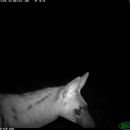en
names in breadcrumbs


Out of the 4060 living mammal species, the aardwolf (Proteles cristatus) is one of 18 species that feed exclusively on termites (Anderson, 2004). However, the aardwolf is specifically adapted to this diet, sporting a large and hairless muzzle (an adaptation that prevents adhesion of the chemical secretions of the soldier termites), a broad tongue and large jaw muscles (their teeth are not suited for hunting larger prey). Unlike other termite-feeding mammals, the aardwolf does not dig for its prey (lacking the well-developed claws and powerful limbs needed for digging), but laps the termites from the open ground (Anderson and Richardson, 2005). Additionally, the nocturnal nature of the aardwolf (hiding in dens during the warm part of the day) is synchronised with the foraging behaviour of the termites Trinervitermes and Hodotermes, the primary diet of the aardwolf (Anderson et al., 1997; Matsebula et al., 2009).
The aardwolf is the smallest of the four members of the Hyaenidae family, weighing in at a mere 8-12 kg (Anderson and Richardson, 2005). It has large pointed ears and an erectile mane running from behind the head to the tip of the tail, and like the hyena, it also has a slightly sloped back as a result of having larger front than back legs (Sliwa, 1996). The aardwolf has characteristic black stripes running across its otherwise cream coloured body.
Reproduction occurs once a year, with roughly 2-5 cubs born to a female after a 90 day gestation period. The cubs remain hidden in the den for a month, after which they start to explore the area around their maternal den. With the arrival of the next litter one year later, the previous litter is forced to seek independence away from their den of birth (Sliwa, 1996).
Its distribution is split into a southern population (P. c. cristatus), limited to the semi-arid areas of southern Africa, and a northern population (P. c. septentrionalis) that extends from northern Tanzania to Somalia (Sliwa, 1996).
Currently, the aardwolf is on the “least concern” list of the IUCN (IUCN Red List of Threatened Species), due to its large distribution range, high numbers of individuals and no major threats to its continued existence.
Aardwolf facts, photos, and videos from ARKive
Aardwolf page @ IUCN Hyaena Specialist Group